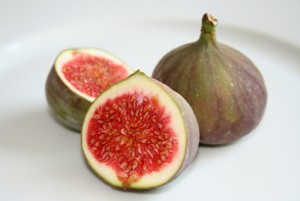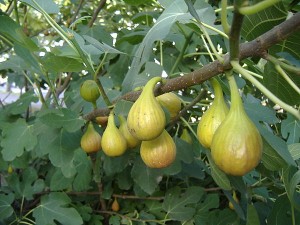The Blessed Fig Juice
Figs, The Blessed Fruit
The Fig fruit is considered one of the world’s oldest fruits. Taxonomically, it belongs to the plant family Moraceae and genus Ficus. Scientifically called Ficus carica, fig fruits are bearings of a deciduous tree or a large shrub which is native to Southwest Asia. Fig fruits are bell-shaped, with a wide, flat bottom and a narrowed pointed top. The top may form “necks” as figs ripen. Their color ranges from brown, purple, green, yellow to black. Fig fruits vary in size but usually have slightly wrinkled and leathery skins. Although they are considered fruits, figs are actually hollow-ended stems or the “false fruits” of the tree in which multiple flowers and seeds are borne. The flower is not visible as it grows inside this false fruit.
Habitats of Fig Trees
 Fig fruits are said to be native to Asia Minor which would today mean that they come from the area from Turkey to Northern India. Later on they spread to all the Mediterranean countries. In 1759 Spanish missionaries were the ones who introduced this fruit to United States when they settled in Southern California. Fig trees were soon cultivated throughout the state. Today, figs are mostly processed into dried figs and are used to replace shortening or oil in baked goods. They are also used in a wide variety of culinary purposes. United States, Turkey, Greece and Spain are the primary producers and exporters of dried figs today.
Fig fruits are said to be native to Asia Minor which would today mean that they come from the area from Turkey to Northern India. Later on they spread to all the Mediterranean countries. In 1759 Spanish missionaries were the ones who introduced this fruit to United States when they settled in Southern California. Fig trees were soon cultivated throughout the state. Today, figs are mostly processed into dried figs and are used to replace shortening or oil in baked goods. They are also used in a wide variety of culinary purposes. United States, Turkey, Greece and Spain are the primary producers and exporters of dried figs today.
 Fig Season and Storage
Fig Season and Storage
Fig fruits ripen during the months of May to November. Take note of these months if you want to get the best figs that are fresh and ripe. Dried figs are never out of season, and they can be found in grocery stores all throughout the year. When you have fresh fully ripen figs you can store them in refrigerator for up to two days.
The Fig Juice
Fig juice is the natural juice from figs. Both fresh and dried figs can be used in making fig juice and the flavor is usually enhanced with the addition of prunes and raisins. Fig juice offers a wide range of health benefits, they also have a mild laxative effect which does not make them unsuitable for children – they are a great substitute to infant formula. Figs are very nutritious fruits, that’s why they are called “blessed fruits”. Their amazing nutritional profile is the reason why they offer so many health benefits. They are also a good source of vitamin B6 as well as other nutrients (check below for a full list of nutritious facts). Fresh-squeezed fig juice has similar composition to breast milk and can be used as already said as an alternative to infant formula.
 The Role of Figs in Ancient Days of Sparta
The Role of Figs in Ancient Days of Sparta
Figs played a significant role in the diet of both Greeks and Romans. Ancient Greek athletes (among the Spartans are the most known), fed on fresh and dried figs to improve their stamina, strength and swiftness. The Romans as well used to feed their slaves with fresh figs during the Ancient times.
Fig Juice Health Facts
- Since fig fruits are low in calories, fig juice as well is low in calories. There are only 74 calories in 100g of fresh figs.
 Fig juice made from fresh figs is rich in flavonoids and antioxidants such as carotenes, lutein and tannins. It is also a good source of the detoxifying vitamins, vitamin A, E and K. Altogether, these phyto-chemical compounds help prevent oxidation of free radicals in the body, thereby protecting us from cancers and other degenerative diseases.
Fig juice made from fresh figs is rich in flavonoids and antioxidants such as carotenes, lutein and tannins. It is also a good source of the detoxifying vitamins, vitamin A, E and K. Altogether, these phyto-chemical compounds help prevent oxidation of free radicals in the body, thereby protecting us from cancers and other degenerative diseases.- Figs contain chlorogenic acid which helps regulate and control blood sugar levels, especially in people with Type 2 Diabetes Mellitus.
- Fig juice is an excellent source of B vitamins including niacin, folates, pyridoxine, and pantothenic acid. These vitamins play several important roles in the body including proper formation of nerve cells, metabolism of carbohydrates, formation of red blood cells, and facilitating most metabolic processes that are essential for life.
- Because figs are excellent sources of folic acid, iron, copper, as well as other minerals, fig juice helps prevent many types of anemia, the condition resulting from a significant decrease of the body’s red blood cells.
Nutrition facts of Fig Fruit
per 100 g
Energy: 74 Kcal
Carbohydrates:
Protein:
Total fat:
Cholesterol:
Dietary Fiber:
Vitamins
Folate: 6 mcg
Niacine: 0.400 mg
Pyridoxine: 0.113 mg
Pantothenic acid: 0.300 mg
Riboflavin: 0.050 mg
Thiamin: 0.060
Vitamin A: 142 IU
Vitamin C: 2 mg
Vitamin E: 0.11 mg
Vitamin K: 4.7 mcg
Minerals/Electrolytes:
Sodium: 1mg
Potassium: 232 mg
Calcium: 35 mg
Iron: 0.37 mg
Magnesium: 0.128 mg
Zinc: 0.15 mg
Phytonutrients
Carotene-ß: 85 mcg
Lutein-zeaxanthin:9mcg
Fig Apple Juice Recipe
Since figs are not the best fruits for juicing – they are not very juicy and don’t contain lots of liquid, 100% pure fig juice is pretty rare (but it does exist!). More common and easier to make are juices made of several different fruits including figs. Here is one of them. This simple recipe will give you a refreshing drink that is also a constipation home remedy. Figs are blended with apple juice and raisins to create a healthy refreshing juice. Dried or fresh figs can be used to make this one. You can drink this juice first thing in the morning.
Ingredients:
1 apple
1 cup dried or fresh figs
1 cup raisins
Instructions:
Slice the apple into chunks and place in a blender. Blend until smooth and juicy, and then set aside. Put one cup of newly prepared apple juice back in the blender. Stir in equal amounts of dry or fresh figs and raisins. Blend for one to two minutes and experiment a little to achieve the right consistency. Add more apple juice if the juice is too thick. Store in refrigerator to chill. Serve and enjoy.
More Articles On Figs And Fig Juice
Best Figs For Fig Juice And How To Choose Them
Figs have a very soft flesh filled with small, edible …Fig Juice Side Effects: Can You Drink Too Much?
The fig fruit is well known for its powers as …Fig Nutrition Facts
Fig Nutrition Facts Betaine 0 mg Calcium 35 mg Calories …Health Benefits Of Fig Juice: Mother Nature’s Most Complete Nutrition Source
Figs are one of humankind’s most ancient food sources. They …